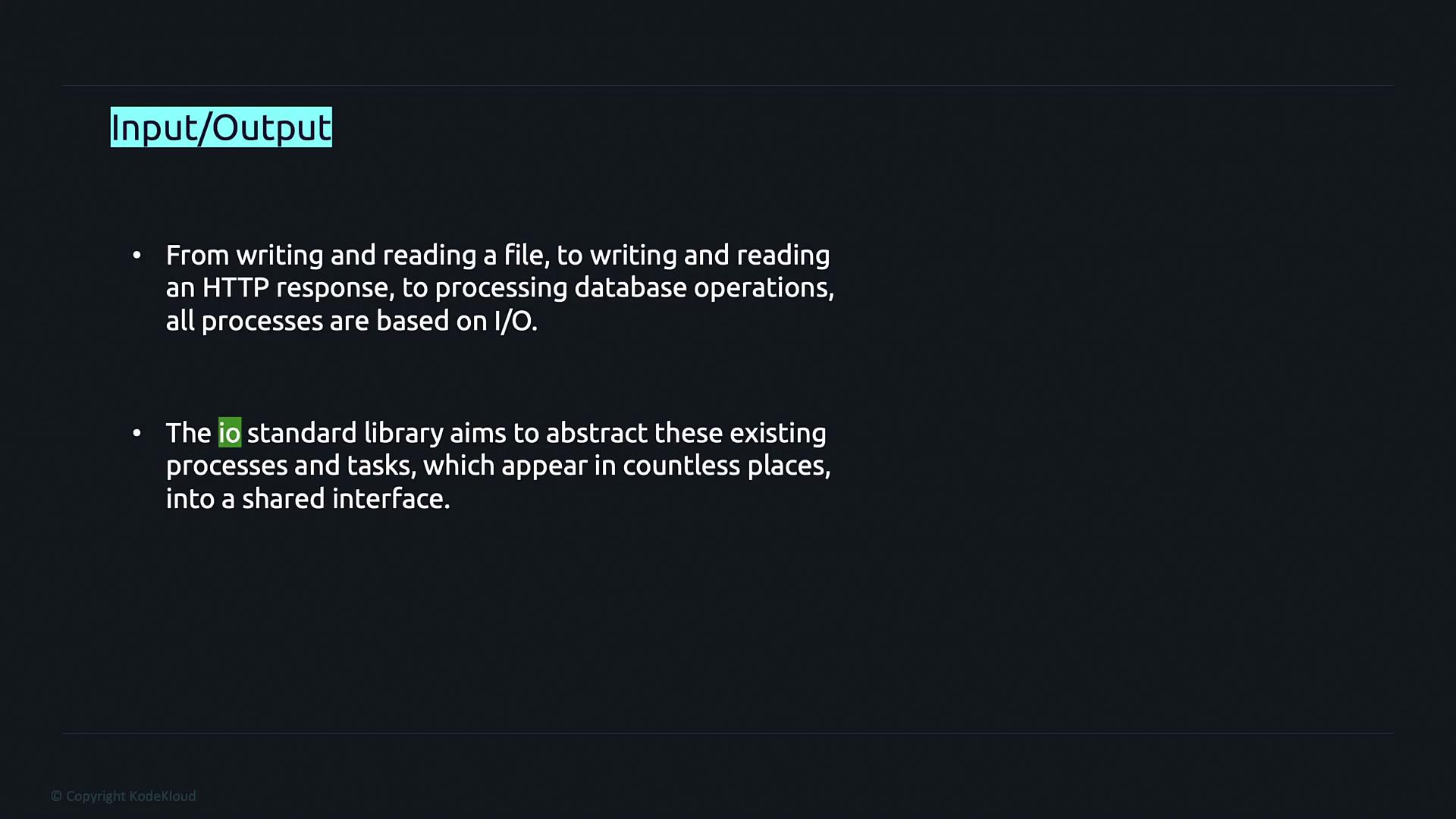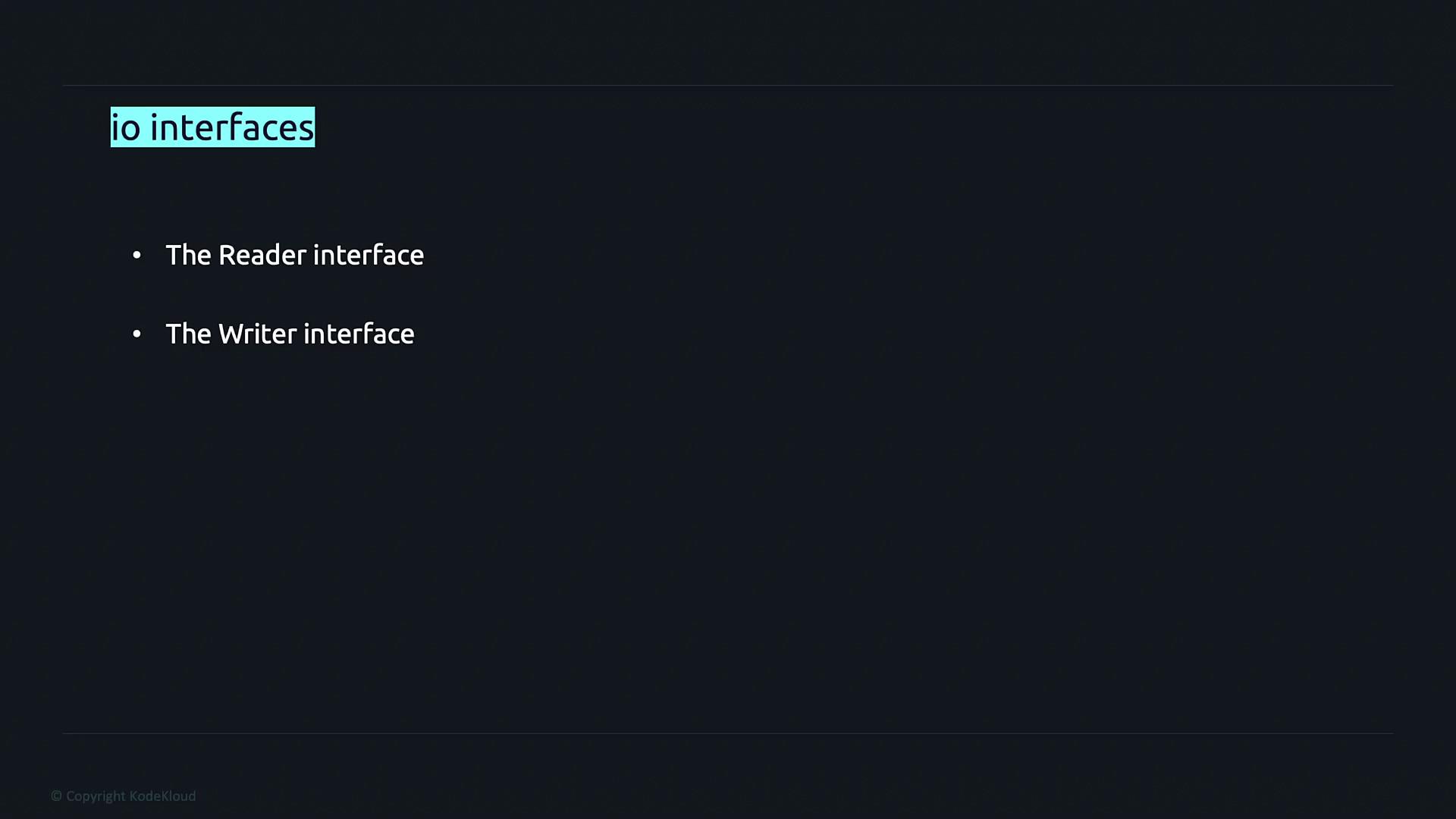Advanced Golang
Core packages
InputOutput
Welcome to this comprehensive guide on Go’s I/O library. This tutorial will help you understand the fundamental concepts of input (Reader) and output (Writer) interfaces along with practical examples for file handling, HTTP responses, database operations, and more. The Go standard library abstracts these tasks into common interfaces, making your code more modular and flexible.

We will start by exploring two primary interfaces in the I/O library: the Reader interface and the Writer interface. Before diving into these specific interfaces, let's quickly review how interfaces work in Go.

The Reader Interface
The Reader interface in Go is designed to provide input functionality from various data sources. It is defined with a single method, Read, which accepts a byte slice and returns the number of bytes read along with any error encountered.
package main
type Reader interface {
Read(p []byte) (n int, err error)
}
In Go, working with byte operations is both common and efficient for processing diverse data types.
The Writer Interface
The Writer interface offers a generic way to output data. It provides a single method, Write, which accepts a byte slice and returns the number of bytes written along with any error that may occur.
package main
type Writer interface {
Write(p []byte) (n int, err error)
}
Note
Go uses implicit interface implementation. Unlike Java or other languages, there is no need to explicitly declare that a type implements an interface. If a type implements all methods of an interface, it is automatically considered to satisfy that interface.
A Custom Interface Example: Shape
To illustrate the power and flexibility of interfaces in Go, consider the following example where we create a custom interface named Shape. This interface includes two methods, Area and Perimeter, both of which return a float64.
We will implement the Shape interface using a struct called Rectangle, which contains two fields: Length and Width.
package main
import (
"fmt"
)
type Shape interface {
Area() float64
Perimeter() float64
}
type Rectangle struct {
Length, Width float64
}
func (r Rectangle) Area() float64 {
return r.Length * r.Width
}
func (r Rectangle) Perimeter() float64 {
return 2 * (r.Length + r.Width)
}
func main() {
var s Shape = Rectangle{Length: 4.0, Width: 6.0}
fmt.Println(s.Area())
fmt.Println(s.Perimeter())
}
When you run this program with the command:
go run main.go
You will see the following output:
24
20
The area is computed as 4 * 6 = 24, and the perimeter is 2 * (4 + 6) = 20. This example clearly demonstrates how to implement an interface in Go.
Revisiting the Reader Interface
Let's delve deeper into the Reader interface using an example from the strings package. Consider the following source code snippet for a reader.go file that defines a Reader struct implementing the io.Reader interface.
Reader Struct Definition
type Reader struct {
s string
i int64 // current reading index
prevRune int // index of previous rune; or < 0
}
Method for Unread Length
A method to get the number of bytes still unread is provided:
// Len returns the number of bytes of the unread portion of the string.
func (r *Reader) Len() int {
if r.i >= int64(len(r.s)) {
return 0
}
return int(int64(len(r.s)) - r.i)
}
Implementing the Read Method
The Read method is the core implementation that satisfies the io.Reader interface:
// Read implements the io.Reader interface.
func (r *Reader) Read(b []byte) (n int, err error) {
if r.i >= int64(len(r.s)) {
return 0, io.EOF
}
r.prevRune = -1
n = copy(b, r.s[r.i:])
r.i += int64(n)
return
}
This method copies bytes from the string into the provided buffer and returns the number of bytes read. When there are no more bytes to read, it returns an EOF error.
Additional Helper Functions
There are helper functions to facilitate working with this Reader:
// Reset resets the Reader to be reading from s.
func (r *Reader) Reset(s string) { *r = Reader{s, 0, -1} }
// NewReader returns a new Reader reading from s.
// It is similar to bytes.NewBufferString but more efficient and read-only.
func NewReader(s string) *Reader { return &Reader{s, 0, -1} }
Using the NewReader Function
The NewReader function allows you to create a new reader instance from a string quickly. The following example shows how to read a string in chunks of 4 bytes:
package main
import (
"fmt"
"strings"
)
func main() {
r := strings.NewReader("Learning is fun")
buf := make([]byte, 4)
n, err := r.Read(buf)
fmt.Println(n, err) // prints the number of bytes read and the error (if any)
}
Run the code with:
go run main.go
The output will be similar to:
4 <nil>
Since the bytes are stored as unsigned 8-bit integers (ASCII values), the buffer contains values corresponding to the characters 'L', 'e', 'a', 'r'. To display the characters, convert the byte slice to a string:
package main
import (
"fmt"
"strings"
)
func main() {
r := strings.NewReader("Learning is fun")
buf := make([]byte, 4)
n, err := r.Read(buf)
fmt.Println(string(buf[:n]), err)
}
This will produce:
Lear <nil>
Reading in a Loop
To read the entire string, you can use a loop that continues until an error (such as io.EOF) is encountered. See the following example:
package main
import (
"fmt"
"strings"
)
func main() {
r := strings.NewReader("Learning is fun")
buf := make([]byte, 4)
for {
n, err := r.Read(buf)
fmt.Println(string(buf[:n]), err)
if err != nil {
fmt.Println("breaking out")
break
}
}
}
A sample output might look like:
Lear <nil>
ning <nil>
is <nil>
fun <nil>
EOF
breaking out
This output demonstrates that the reader returns data in chunks of 4 bytes (or fewer when the remaining data is less), and then signals the end of the input with an EOF error.
The Writer Interface and Using io.Copy
The Writer interface simplifies the process of outputting data to various destinations. One common use case is copying data from a Reader to a Writer using the io.Copy function. In this example, we create a Reader and use io.Copy to write its contents to os.Stdout:
package main
import (
"io"
"log"
"os"
"strings"
)
func main() {
r := strings.NewReader("some io.Reader stream to be read\n")
if _, err := io.Copy(os.Stdout, r); err != nil {
log.Fatal(err)
}
}
Run the code with:
go run main.go
The output will be:
some io.Reader stream to be read
The io.Copy function efficiently transfers data from a source (which implements io.Reader) to a destination (which implements io.Writer). In this example, os.Stdout is used as the destination writer.
The Writer Implementation in os.File
The os.Stdout variable is of type *os.File. The File struct in the os package implements the Write method to satisfy the Writer interface. Below is an excerpt from the source code of the Write method:
// Write writes len(b) bytes from b to the File.
// It returns the number of bytes written and an error, if any.
// Write returns a non-nil error when n != len(b).
func (f *File) Write(b []byte) (n int, err error) {
if err := f.checkValid("write"); err != nil {
return 0, err
}
n, e := f.write(b)
if n < 0 {
n = 0
}
if n != len(b) {
err = io.ErrShortWrite
}
epipecheck(f, e)
if e != nil {
err = f.wrapErr("write", e)
}
return n, err
}
Because the File type implements the Write method, it inherently satisfies the Writer interface, allowing its seamless use as the destination in functions like io.Copy.
Conclusion
In this tutorial, we explored how Go’s I/O library encapsulates input and output operations through the Reader and Writer interfaces. We looked at:
- Basic definitions and implementations of the Reader and Writer interfaces.
- A custom interface example using the
Shapeinterface for aRectangle. - Detailed examples from the
stringspackage that implement and demonstrate the usage of the Reader interface. - The use of the
io.Copyfunction to connect Reader and Writer interfaces, along with insights into the underlying implementation inos.File.
These concepts are indispensable for handling file operations, network communications, and more in Go. For further reading, consider checking out the Go Documentation for more details.
Happy coding!
Watch Video
Watch video content